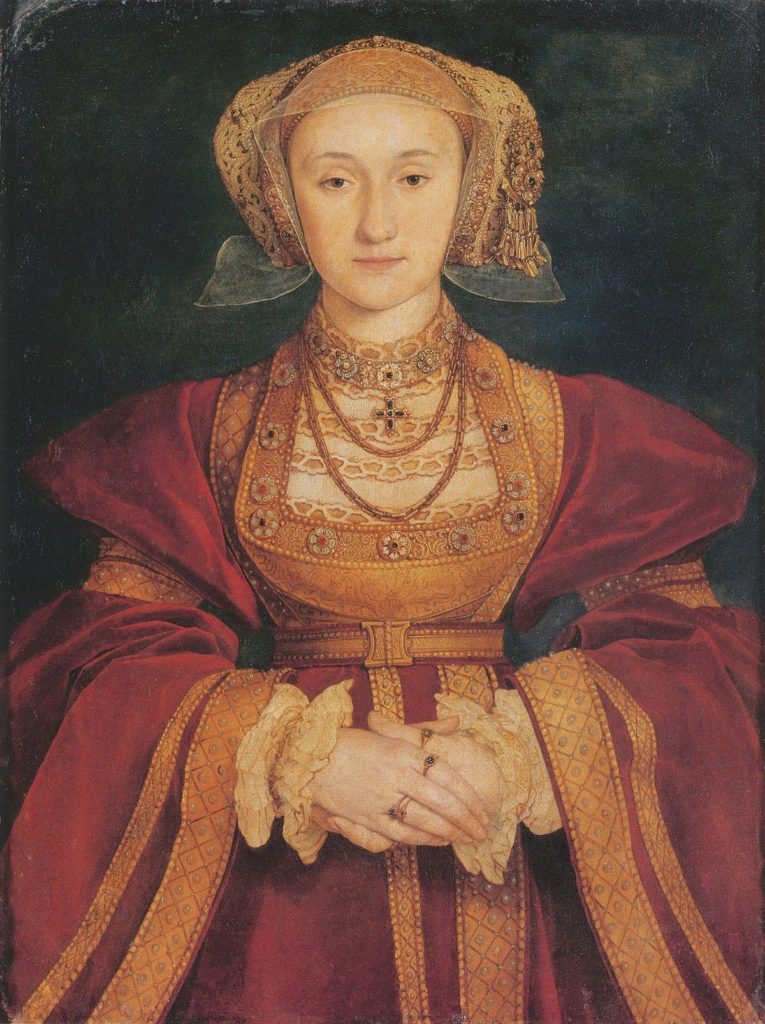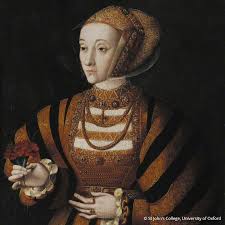
Ever get that feeling that people are making fun of your appearance behind your back? If so, spare a thought for poor Anne of Cleves. She’s been trying to shake off that feeling for almost 500 years.
Anne and Henry VIII’s non-love story is well known to most Royal History Geeks. After the death of his beloved Jane Seymour, Henry allowed his ministers to open international negotiations for a new bride. Each minister had their own political and religious agenda. Cromwell eventually triumphed by convincing Henry of the virtues of an alliance with the almost-protestant province of Cleves. The beauty of its princess was a major draw. Hans Holbein, the great artist of the Tudor court, was dispatched to Cleves to paint Anne’s portrait. The result did not disappoint. Henry fell instantly in love.
But his delusions were quickly shattered.
Upon meeting his new bride, Henry expressed dismay. “I like her not,” he is supposed to have proclaimed. While it was too late to postpone the nuptials, he quickly informed his doctor that the union remained unconsummated. He complained that Anne had been unable to arouse him and that her body was undesirable. Even her personal hygiene, Henry suggested, left much to be desired. He never actually used the term ‘Flanders mare’ to describe her. But it’s easy to see why it stuck.
Anne’s side of the story remains a mystery. It’s possible that she was no great beauty. Most people aren’t. But there are several reasons to think that she was far from ugly. Here’s just a few of them.
- When Henry met her, he kissed her
Upon arriving in England, Anne believed she had several days to prepare herself for meeting the King. But an infatuated Henry couldn’t wait. Accompanied by five of his councillors, he went to Anne disguised as a messenger, bearing a gift from the King.
The cultivated Katherine of Aragon or the sophisticated Anne Boleyn would have recognised straight away that this was a courtly game. The messenger was clearly her knight in disguise and her heart should recognise him at once. Sadly, no one had prepared Anne of Cleves for the courtly culture of England. When the ‘messenger’ grabbed and kissed her, she was reportedly ‘abashed’. She proceeded to treat him as a servant and largely ignored him.
This is the moment it all went wrong for Henry and Anne. She had demonstrated her cultural ignorance. He had been publicly humiliated. What is less often remarked upon, is Henry’s initial reaction to Anne. He had fallen in love with her portrait and was said to be disappointed with the real thing. Yet, his first action upon meeting her was to grab her and kiss her. Was he just swept up in the moment? Or, when he first set eyes on the Princess, did he conclude that she was eminently grabbable and kissable?
2. Anne seemed to think she was more attractive than Katherine Parr
While Anne was surely happy to escape certain aspects of her marriage, there are signs that she felt slighted when Henry did not take her back after the fall of Katheryn Howard. When it was announced that the King was to marry Lady Latimer (better known to us as ‘Katherine Parr’) Anne was heard to remark that she was a good deal more attractive than the Queen to be.
Obviously, the fact Anne thought positively about her appearance doesn’t mean that others agreed. We can all delude ourselves. But it should be noted that the imperial ambassador Chapuys, who reported these remarks, was quite capable of adding his own opinions to his observations. If he had felt that Anne was deluded, he might well have mentioned it.

3. Holbein was never punished for the portrait of Anne
As we know, Henry fell in love with a portrait. Given his reaction to Anne once they met, it is often assumed the painting must have been deliberately distorted. Yet, Hans Holbein, the artist behind the miniature that captivated Henry’s heart, remained in favour. He stayed on the King’s payroll and went on to paint another portrait of Henry.
Holbein may have embellished a little. That was to be expected. Alison Weir has also noted that, when compared to some of Anne’s other portraits, it’s clear that Holbein chose to paint Anne at her most flattering angle. But there’s a difference between a flattering picture and a fake one.
*
Ultimately Henry and Anne lacked one crucial ingredient: chemistry. That concept which is so hard to define yet so essential for the blossoming of romance. Though he would never have used the word, it was an important concept to the King. He had built up such an impression of Anne in his head. He had fallen in love with a woman that didn’t exist. She had failed her first courtly challenge. They were doomed from the start.
In later years, a friendship emerged. They ate together and talked. Henry seems to have enjoyed her company. She may have felt the same. Perhaps if the circumstances had been different and Henry had been allowed to fall for her freely as he had all the other loves of his life, history would have taken a different turn.
Subscribe to our newsletter!